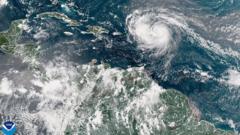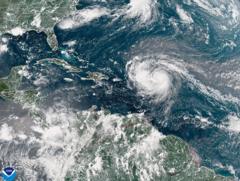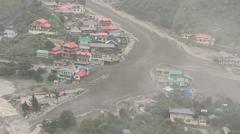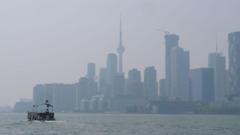As Hurricane Erin intensifies, residents of the eastern United States must prepare for hazardous surf and rip currents, with the storm already impacting the southeast Bahamas.
Hurricane Erin Strengthens, Poses Serious Threat to US East Coast

Hurricane Erin Strengthens, Poses Serious Threat to US East Coast
Hurricane Erin has escalated to a Category 4 storm, bringing potentially life-threatening ocean conditions to the US East Coast.
The first hurricane of the 2025 Atlantic season, Erin's powerful winds and rains have begun to affect multiple locations. Fortunately, its trajectory suggests it will steer clear of a direct hit on the Bahamas, but caution is advised as its outer rain bands make landfall. While the storm has recently fluctuated between categories, it remains classified as a Category 4 hurricane, continuing to bring severe weather to the region.
The storm has already left over 150,000 people without power in Puerto Rico following the damaging winds, though emergency repairs have restored power to approximately 95% of customers. Rainfall predictions for the Turks and Caicos Islands and the eastern Bahamas reach up to six inches, prompting local authorities to recommend that residents prepare for possible evacuation.
Bahamians are urged to identify the closest emergency shelters, as the unpredictable nature of hurricanes poses a serious risk. Meanwhile, the US National Hurricane Center anticipates Erin to pass just east of the Bahamas, moving between Bermuda and the eastern US coast mid-week. The Outer Banks of North Carolina have begun implementing mandatory evacuations, with rising concerns over powerful surf conditions.
Officials continue to warn of dangerous rip tides and other hazardous conditions extending along the entire US East Coast, underscoring the looming threat posed by Hurricane Erin.
The storm has already left over 150,000 people without power in Puerto Rico following the damaging winds, though emergency repairs have restored power to approximately 95% of customers. Rainfall predictions for the Turks and Caicos Islands and the eastern Bahamas reach up to six inches, prompting local authorities to recommend that residents prepare for possible evacuation.
Bahamians are urged to identify the closest emergency shelters, as the unpredictable nature of hurricanes poses a serious risk. Meanwhile, the US National Hurricane Center anticipates Erin to pass just east of the Bahamas, moving between Bermuda and the eastern US coast mid-week. The Outer Banks of North Carolina have begun implementing mandatory evacuations, with rising concerns over powerful surf conditions.
Officials continue to warn of dangerous rip tides and other hazardous conditions extending along the entire US East Coast, underscoring the looming threat posed by Hurricane Erin.





















